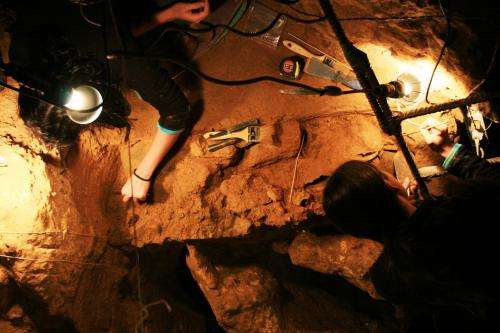Scientists provide more accurate age for the El Sidron cave Neanderthals

A study has been able to accurately determine the age of the Neanderthal remains found in the El Sidrón cave (Asturias, Spain) for which previous studies had provided inexact measurements. The application of a pre-treatment to reduce contamination by modern carbon has managed to lower the margin of error from 40,000 to just 3,200 years.
El Sidrón cave in Asturias (northern Spain) is one of the westernmost Neanderthal sites on the Iberian Peninsula and contains a large amount of this type of remains in addition to the flint tools they used. Now, thanks to the development of new analytical procedures, a research team co-ordinated by the University of Oviedo (Spain) has managed to provide a more accurate dating for these Neanderthal populations in Asturias.
The age of the El Sidrón remains could prove to be an important piece of information in the discussion about when the transition from Neanderthal to Homo sapiens took place in Europe. "Some previous datings that stated the remains were only 10,000 years old are inconsistent and cannot be considered credible. They would be highly disputed in the discussion about when Homo neanderthalensis became extinct," as explained to SINC by Marco de la Rasilla, co-ordinator of the research team.
In order to adjust the age of these Neanderthals, De La Rasilla and his team compared previous results from the French Climate and Environmental Sciences Laboratory (LSCE, its acronym in French), with new data obtained by the Oxford Radiocarbon Accelerator Unit (ORAU). The datings provided by both laboratories have enabled them to confirm that the Neanderthals from the Asturian cave lived some 49,000 years ago.
"The previous measurement of 10,000 years for this episode was due to a contamination issue," De La Rasilla explained. Carbon-14 is the most widely-used dating method in archaeology and it measures the age of the carbon found in an object. If the sample becomes contaminated with modern carbon or other substances then the object may appear younger than it actually is.
The new carbon-14 dating in Oxford's ORAU laboratory was preceded by a highly sophisticated ultrafiltration treatment to reduce contamination as much as possible. The results revealed that the remains are between 45,200 and 51,600 years old.
The weighted average between this data and the data obtained previously by the French laboratory, where the sample underwent a different pre-treatment with ninhydrin to remove contaminants, places the Neanderthal inhabitants of El Sidrón 49,000 years ago. "The fact that two separate laboratories using different treatments came up with similar figures makes this date even more reliable" De La Rasilla concluded.
More information: R. E. Wood, T. F. G. Higham, T. de Torres, N. Tisnerat-Laborde, H. Valladas, J. E. Ortiz, C. Lalueza-Fox, S. Sánchez-Moral, J. C. Cañaveras, A. Rosas, D. Santamaría, M. De La Rasilla. 2013. "A new date for the Neanderthals from El Sidrón cave (Asturias, northern Spain)". Archaeometry, 55, 1, pp.148-158. DOI: 10.1111/j.1475-4754.2012.00671.x
T. de Torres, J. E. Ortiz, R. Grün, S. Eggins, H. Valladas, N. Mercier, N. Tisnérat-Laborde, R. Julià, V. Soler, E. Martínez, S. Sánchez-Moral, J. C. Cañaveras, J. Lario, E. Badal, A. Rosas, D. Santamaría, M. de la Rasilla, J. Fortea. 2010. "Dating of the hominid (Homo Neanderthalensis) remains accumulation from El Sidrón cave (Borines, Asturias, North Spain): an example of multi-methodological approach to the dating of Upper Pleistocene sites". Archaeometry, 52, 4, pp. 680-705. DOI: 10.1111/j.1475-4754.2009.00671.x
Journal information: Archaeometry




















